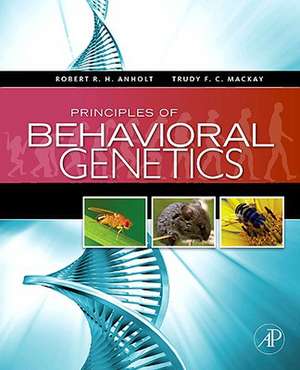Principles of Behavioral Genetics
Autor Robert R.H. Anholt, Trudy F. C. Mackayen Limba Engleză Paperback – 19 oct 2009
Introductory chapters give clear explanations of basic processes of the nervous system and fundamental principles of genetics of complex traits without excessive statistical jargon. Individual chapters describe the genetics of social interactions, olfaction and taste, memory and learning, circadian behavior, locomotion, sleep, and addiction, as well as the evolution of behavior.
Whereas the focus is on genetics, neurobiological and ecological aspects are also included to provide intellectual breadth. The book uses examples that span the gamut from classical model organisms to non-model systems and human biology, and include both laboratory and field studies. Samples of historical information accentuate the text to provide the reader with an appreciation of the history of the field.
This book will be a valuable resource for future generations of scientists who focus on the field of behavioral genetics.
- Defines the emerging science of behavioral genetics
- Engagingly written by two leading experts in behavioral genetics
- Clear explanations of basic quantitative genetic, neurogenetic and genomic applications to the study of behavior
- Numerous examples ranging from model organisms to non-model systems and humans
- Concise overviews and summaries for each chapter
Preț: 317.05 lei
Preț vechi: 419.46 lei
-24% Nou
Puncte Express: 476
Preț estimativ în valută:
60.68€ • 63.11$ • 50.09£
60.68€ • 63.11$ • 50.09£
Carte tipărită la comandă
Livrare economică 07-21 aprilie
Preluare comenzi: 021 569.72.76
Specificații
ISBN-13: 9780123725752
ISBN-10: 0123725755
Pagini: 344
Dimensiuni: 216 x 276 x 20 mm
Greutate: 0.93 kg
Ediția:New.
Editura: ELSEVIER SCIENCE
ISBN-10: 0123725755
Pagini: 344
Dimensiuni: 216 x 276 x 20 mm
Greutate: 0.93 kg
Ediția:New.
Editura: ELSEVIER SCIENCE
Public țintă
Advanced undergraduate and graduate students in genetics, neuroscience, or ecology courses on behavior.Cuprins
Preface
Chapter 1: Introduction and Historical Perspective
Overview
The Rise of the Modern Field of Behavioral Genetics
The Modern Evolutionary Synthesis
The Rise of Molecular Genetics
A Brief History of Neuroscience
The Emergence of Behavioral Genetics
Summary
Study Questions
Recommended Reading
Chapter 2: Mechanisms of Neural Communication
Overview
Transmission of Information in the Nervous System
The Resting Membrane Potential
The Mechanism of the Action Potential
Ion Channels, G-protein-coupled Receptors, and Signal Transduction
Summary
Study Questions
Recommended Reading
Chapter 3: Functional Organization of the Nervous System
Overview
The Organization of the Mammalian Nervous System
Communication between the Brain and the Periphery
Organization of the Nervous System in Insects
Neurotransmitters
Summary
Study Questions
Recommended Reading
Chapter 4: Measuring Behavior: Sources of Genetic and Environmental Variation
Overview
Behavioral Assays
Controlling Experimental Variation
Sources of Variation in Behavior
Effects of Mutations on Behavioral Phenotypes
Environmental Variation
Gene – Environment Correlation and Interaction
Summary
Study Questions
Recommended Reading
Chapter 5: Mapping Genotype to Phenotype in Populations
Overview
Genes in Populations: Random Mating
Genes in Populations: Inbreeding
Quantitative Genetic Model
Summary
Study Questions
Recommended Reading
Chapter 6: Partitioning Phenotypic Variance and Heritability
Overview
Components of Variance in Random Mating Populations
Genotype–Environment Correlation and Interaction
Partitioning Phenotypic Variance
Heritability : The Concept
Controlling and Estimating Environmental Components of Variation
Summary
Study Questions
Recommended Reading
Chapter 7: Estimating Heritability
Overview
Phenotypic Resemblance between Relatives
Genetic Causes of Covariance between Relatives
Environmental Causes of the Relationship between Relatives
Heritability Estimates in Humans
Heritability in Other Populations
Estimates of Heritability for Behavioral Traits
Summary
Study Questions
Recommended Reading
Chapter 8: Quantitative Trait Locus Mapping
Overview
Linkage Mapping
Interval Mapping
Statistical Analysis
Association Mapping
Quantitative Trait Locus End Game
Summary
Study Questions
Recommended Reading
Chapter 9: Mutagenesis and Transgenesis
Overview
The Occurrence or Induction of Mutations
Homologous Recombination
Transposon -mediated Mutagenesis
The GAL4-UAS Binary Expression System in Drosophila
RNA Interference
Summary
Study Questions
Recommended Reading
Chapter 10: Genomics Approaches in Behavioral Genetics
Overview
Detecting Large-scale Gene Expression
Parallel Sequencing and Transcriptional Analysis
Plasticity of Transcriptional Profiles
Analysis of Whole-genome Expression Microarray
Defining Statistical Signifi cance Threshold
Identifying Genetic Networks
Summary
Study Questions
Recommended Reading
Chapter 11: Neurogenetics of Activity and Sleep
Overview
Locomotion
Genetics of Human Locomotion Disorders
Circadian Rhythms
Sleep
Summary
Study Questions
Recommended Reading
Chapter 12: Genetics of Social Interactions
Overview
Social Environment and the Genes–Brain–Behavior Paradigm
Social Cooperation and Fitness
Courtship and Mate Selection
Affiliative Behavior
Aggression and the Establishment of Social Hierarchies
Division of Labor: The Genetics of Social Structure
Aggregation Behavior
Summary
Study Questions
Recommended Reading
Chapter 13: Genetics of Olfaction and Taste
Overview
The Study of Olfaction
The Discovery of Odorant Receptors
Transgenic Approaches to Determine Odorant Receptor Response Profiles
Transgenic Approaches to Map Projection Patterns of Olfactory Sensory Neurons
The Use of Transgenic Reporter Genes to Visualize Odor Coding
Taste and Gustatory Receptors
Summary
Study Questions
Recommended Reading
Chapter 14: Learning and Memory
Overview
Forming Memories
Memory Formation: Cellular Mechanisms
Harnessing the Power of Genetics: Learning in Drosophila
Identifying Genetic Networks for Learning and Memory
Learning Disabilities
Neurodegeneration and Memory Impairment: Alzheimer’s Disease
Summary
Study Questions
Recommended Reading
Chapter 15: Genetics of Addiction
Overview
Hallmarks of Addiction
Alcoholism
Linkage and Association Studies
Alcohol Sensitivity in Model Organisms
Alcohol-related Phenotypes in Rodent Models
Smoking
Drug Addiction
Summary
Study Questions
Recommended Reading
Chapter 16: Evolution of Behavior
Overview
Population Genetics and Evolution
Models of Evolution
Selection Models
Assessing Deviations from Neutrality
Behavior as a Vehicle for Evolution
Insect–Host Plant Interactions: An Example of Evolutionary Adaptation
Co-evolution of Sexual Communication Systems
Study Questions
Recommended Reading
Chapter 16: Evolution of Behavior
Overview
Population Genetics and Evolution
Models of Evolution
Selection Models
Assessing Deviations from Neutrality
Behavior as a Vehicle for Evolution
Insect–Host Plant Interactions: An Example of Evolutionary Adaptation
Co-evolution of Sexual Communication Systems
The Evolutionary Genetics of Burrowing and Nest Building
The Astounding Diversity of Cichlids and Sticklebacks
Understanding the Evolution of Behavior: How Much Do We Really Know?
Summary
Study Questions
Recommended Reading
Glossary
Index







